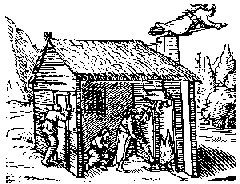
There were stereotypes of a witch for both men and women. Though they do have their differences, they share the common link of being outsiders within or around the community. For example, common stereotypes of the female witch include such things as being old. She was also said to have had some form of a "Devil's mark." That is, a spot on her body where a familiar was presumed to have taken blood or other bodily fluids from her.
The sterotypical witch was also often widowed. With no husband to keep control of her, what else could she do but turn to evil?
In this time, there was also the notion that witches cursed because they were denied charity. It served as a perfect motive for revenge. This plays to the idea that alms and charity to the needy were an accepted part of early modern European society, and also ties in the idea of fear: recognition that one had mistreated another, and thus feared the ramifications of that mistreatment. An otherwise innocent mutter under the breath became an intolerable challenge which had to be destroyed.
Community life and involvement was very important to survival and acceptance in Early Modern Europe. Living on the outskirts of society, then, was seen as something out of the ordinary. Clearly, if she wasn't involved in the community somehow, something was very wrong said the common perception and she ran the risk of being labeled as an outsider or an other.
Finally, the witch woman was often poor. Poor people were often suspect in a number of crimes simply for being poor.
Meanwhile, sterotypes of the male witch went along similar lines. A male witch could often be a vagabond. In this era, being able-bodied but not employed or actively seeking work was seen as a sign of idleness, laziness, and association with the devil. In another similar fashion to the female witch, a man accused of witchcraft may have been a hermit. Much like the witch on the outskirts of the community, a hermit also failed to fit into the community properly and left himself self open to being labeled as an "other. Finally, the male witch was also often poor and uneducated.